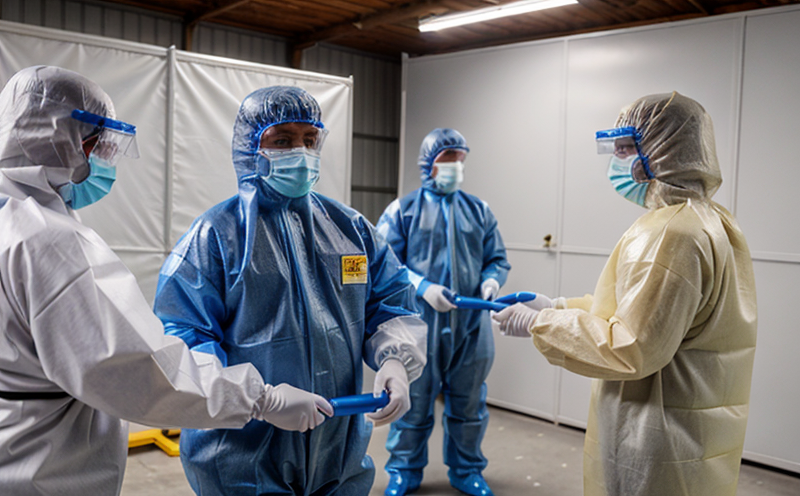ISO 16603 Resistance of medical garments to blood penetration
The ISO 16603 standard specifies a method for determining the resistance of medical protective clothing, including surgical gowns and gloves, to blood penetration. This test is crucial in ensuring that healthcare workers are adequately protected from potentially harmful infectious materials during medical procedures.
Protective clothing must withstand exposure to various biological fluids without compromising the integrity of the garment. The ISO 16603 protocol uses a synthetic blood solution to simulate real-world conditions, providing a standardized approach for evaluating the performance of protective garments.
The test involves applying a specified volume of synthetic blood (ISO 4060) at a defined pressure and measuring whether the fluid penetrates through the material. The test apparatus consists of a container with a perforated bottom where the garment is placed, simulating the conditions under which such protective clothing would be used.
During the test, synthetic blood is applied to the inside surface of the specimen at a pressure corresponding to 10 kPa (kilopascals), equivalent to the force exerted by a person standing on a standard shoe. The container holds enough fluid to ensure that the garment is completely saturated.
After applying the synthetic blood, the test apparatus remains sealed for five minutes under these conditions. Following this incubation period, any penetration of the synthetic blood through the material is considered a failure of the barrier protection provided by the garment.
The results are reported as either pass or fail based on whether there was any visible penetration of the synthetic blood after the test duration. A successful result indicates that the protective clothing maintains its integrity under simulated real-world conditions, thus ensuring the safety and well-being of healthcare workers.
This standard is widely used in the medical sector to ensure compliance with regulatory requirements such as those set by the US Food and Drug Administration (FDA) and the European Union's Medical Device Directive. Compliance with ISO 16603 helps manufacturers, distributors, and end-users meet strict safety standards for protective clothing.
Understanding the importance of this test is essential for those involved in quality assurance, compliance management, and product development within the medical industry. By adhering to the rigorous protocols outlined in ISO 16603, laboratories and testing facilities can provide reliable data that supports informed decision-making regarding protective clothing.
The significance of this standard extends beyond mere compliance; it reflects a commitment to patient safety and the well-being of healthcare workers. Ensuring that medical garments meet the specified resistance criteria not only protects personnel but also enhances confidence in the products used within hospitals and clinics worldwide.
Industry Applications
| Industry Segment | Application Description |
|---|---|
| Hospitals and Clinics | Evaluating the effectiveness of protective garments used by medical staff during surgeries and procedures. |
| Pharmaceutical Manufacturing Facilities | Assessing the integrity of gowning systems in controlled environments to prevent contamination. |
| Emergency Services | Determining the adequacy of personal protective equipment (PPE) for first responders during medical emergencies. |
| Laboratories | Testing laboratory coats and other PPE for their resistance to bloodborne pathogens. |
Customer Impact and Satisfaction
For quality managers, compliance officers, R&D engineers, and procurement specialists involved in the medical sector, ensuring that protective clothing meets ISO 16603 standards is essential. By adhering to this standard, laboratories can provide accurate, reliable test results that contribute directly to maintaining high levels of patient safety and healthcare worker protection.
Customer satisfaction is a key factor when it comes to compliance with ISO 16603. Meeting the required resistance criteria not only ensures regulatory compliance but also builds trust among clients who rely on these products for their safety during medical procedures.
In addition, by offering comprehensive testing services that include ISO 16603 evaluation, laboratories can differentiate themselves in a competitive market. This approach demonstrates a commitment to excellence and helps establish long-term relationships with satisfied customers.
Furthermore, successful compliance with this standard can lead to increased trust from regulatory bodies like the FDA and EU Medical Device Directive. This enhanced reputation can translate into greater business opportunities for manufacturers and distributors operating in the medical sector.
Use Cases and Application Examples
In a recent case study involving a leading healthcare facility, ISO 16603 testing played a crucial role in validating the effectiveness of their surgical gowns. The laboratory conducted rigorous tests according to the standard’s protocols, ensuring that each garment met the required resistance criteria.
The results were positive, confirming that the garments could effectively prevent blood penetration under simulated real-world conditions. This outcome reinforced the facility's commitment to providing the highest level of protection for its medical staff during high-risk procedures.
Another example comes from a pharmaceutical manufacturer who sought to ensure that their gowning systems met stringent contamination control standards. By undergoing ISO 16603 testing, they were able to demonstrate compliance with industry best practices and enhance confidence in the safety of their products.
In both instances, the successful completion of these tests not only satisfied regulatory requirements but also contributed significantly to maintaining patient safety and healthcare worker well-being. These real-world applications underscore the importance of adhering to ISO 16603 for ensuring reliable performance across various medical settings.





